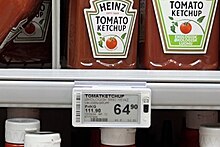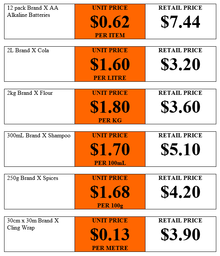
Unit price information printed on supermarket shelf labels (price tickets) illustrates the quantity of product by a unit of measure (price per 100 g, price per 100 ml).
Unit pricing was originally designed as a device to enable customers to make comparisons between grocery products of different sizes and brand, hence enabling informed purchase decisions. The provision of prescribed product quantities enable supermarket shoppers to discriminate intelligently between competing goods of different shapes and sizes.
There remains debate about the extent of consumer awareness, understanding and adoption of this information. It is argued that as a measure of a consumer's understanding of unit pricing, comprehension is richer in content and thus reveals more information compared to awareness. Although higher levels of awareness is self reported, only 56% of shoppers could provide satisfactory descriptions of how to use unit price information. The difference between reported awareness and comprehension is often large.
Unit pricing was implemented into British, European Union and North American markets during the early 1970s. In December 2009, the Australian federal government implemented Trade Price legislation to force all large supermarkets and groceries stores to display unit pricing information on shelf labels (s.51AE, Trade Practices Act 1974).
As products have become qualitatively diverse, comprising various ply constructions, densities and concentrations, consumer awareness and usage of unit price information continues to hold academic interest.(Jarratt 2007; Kachersky 2011; Diaz 2011).
The benefits of unit pricing have been widely reported in the literature. It has been argued that unit pricing reduces time spent comparing brands, eliminates confusion relating to price calculations and ultimately allows shoppers to save money at the register. Unit pricing enables the consumers to rationally evaluate the most economic package size and brand. Accordingly, the time spent determining the most economic purchase is condensed substantially, errors in product price comparisons are significantly reduced, and importantly, lower grocery shopping expenditure is attained. In Australia, despite having unit pricing legislation, there were no adequate education programs to enable consumers to take advantage of unit pricing.
Research indicates that when consumers are educated about unit pricing they can show around 17-18% savings in shopping expenditure, but that this can often drop back somewhat across time

Further reading
- Mortimer, Gary & Clarke, Peter (2011) Supermarket consumers and gender differences relating to their perceived importance levels of store characteristics. Journal of Retailing and Consumer Services, 18(6), pp. 575–585. http://eprints.qut.edu.au/46344/
- Mortimer, Gary & Weeks, Clinton (2011) Grocery product pricing and Australian supermarket consumers : gender differences in perceived importance levels. The International Review of Retail, Distribution and Consumer Research, 21(4), pp. 361–373. http://eprints.qut.edu.au/46337/
- Mortimer, Gary (2011) The emergent male shopper : an identification of male supermarket shopper types. In Proceedings of the Academy of Marketing Conference 2011: Marketing Fields Forever, University of Liverpool, Liverpool. http://eprints.qut.edu.au/46374/
- Mortimer, Gary & Clarke, Peter (2010) Gender differences and store characteristics : a study of Australian supermarket consumers. In Ballantine, Paul & Finsterwalder, Jorg (Eds.) Proceedings of ANZMAC 2010, University of Canterbury, New Zealand, University of Canterbury, Christchurch, pp. 1–5. http://eprints.qut.edu.au/41588/
References
- ^ Mitchell, V. W., D. Lennard and P. McGoldrick. (2003). "Consumer Awareness, Understanding and Usage of Unit Pricing". British Journal of Management. 14 (2): 173–187. doi:10.1111/1467-8551.00273. S2CID 153323897.
{{cite journal}}: CS1 maint: multiple names: authors list (link) - ^ Boya, U. O. (1987). "Consumer Usage of Unit Pricing". Journal of Consumer Studies and Home Economics. 11 (3): 279–293. doi:10.1111/j.1470-6431.1987.tb00140.x.
- Monroe, K. B. & P. J. LaPlaca. (July 1972). "What are the Benefits of Unit Pricing?". Journal of Marketing. 36 (3): 16–22. doi:10.2307/1251035. JSTOR 1251035.
- McGoldrick, P. & H. Marks. (July–August 1983). "A Case for Unit Pricing?". Journal of Retail and Distribution Management. 11 (4): 46–50. doi:10.1108/eb018195.
- Houston, M. J. (July 1972). "The Effect of Unit Pricing on Choices of Brand and Size Economic Shopping". Journal of Marketing. 36 (3): 51–69. doi:10.2307/1251040. JSTOR 1251040.
- Isakson, H. R. & A. R. Maurizi. (August 1973). "The Consumer Economics of Unit Pricing". Journal of Marketing Research. 10 (3): 277–285. doi:10.2307/3149695. JSTOR 3149695.
- Kilbourne, W. E. (November 1974). "A Factorial Experiment on the Impact of Unit Pricing on Low-Income Consumers". Journal of Marketing Research. 11 (4): 453–455. doi:10.2307/3151296. JSTOR 3151296.
- ^ Lamont, L. M., J. Rothe and C. Slater (1972). "Unit Pricing: A Positive Response to Consumerism". European Journal of Marketing. 6 (4): 223–233. doi:10.1108/eum0000000005144.
{{cite journal}}: CS1 maint: multiple names: authors list (link) - McCullough, D. T. & D. I. Padberg. (January 1971). "Unit Pricing in Supermarkets: Alternatives, Costs and Consumer Reactions". Search Agriculture. 1: 1–22.
- Price, C. C. (1978). "Consumer Awareness and Use of Unit Pricing". U.S. Department of Agriculture.
- ^ Miyazaki, A. D., D. E. Sprott and K. C. Manning. (2000). "Unit Prices on Retail Shelf Labels: An Assessment of Information Prominence". Journal of Retailing. 76 (1): 93–112. doi:10.1016/s0022-4359(99)00022-6.
{{cite journal}}: CS1 maint: multiple names: authors list (link) - Russo, E. J., G. Krieser and S. Miyashita. (April 1975a). "An Effective Display of Unit Price Information". Journal of Marketing. 39 (2): 11–19. doi:10.2307/1250110. JSTOR 1250110.
{{cite journal}}: CS1 maint: multiple names: authors list (link) - Russo, J. E., G. Krieser and S. Miyashita (1975b). "An effective display of unit price information". Journal of Marketing. 39 (2): 11–19. doi:10.2307/1250110. JSTOR 1250110.
{{cite journal}}: CS1 maint: multiple names: authors list (link) - "Shoppers Being Ripped Off Through Poor Unit Pricing Education", Finance Friend, September 13, 2014, Retrieved January 19, 2016.
- Weeks, Clinton S.; Mortimer, Gary; Page, Lionel (September 2016). "Understanding how consumer education impacts shoppers over time: A longitudinal field study of unit price usage" (PDF). Journal of Retailing and Consumer Services. 32: 198–209. doi:10.1016/j.jretconser.2016.06.012.
- Aaker, D. A. & G. T. Ford (1983). "Unit Pricing Ten Years Later: A Replication". Journal of Marketing. 47 (Winter): 118–122. doi:10.2307/3203433. JSTOR 3203433.
- Carman, J. M. (1973). "A Summary of Empirical Research in Unit Pricing". Journal of Retailing. 48 (Winter): 63–72.
- McElroy, B. F. & D. A. Aaker. (1979). "Unit Pricing Six Years After Introduction". Journal of Retailing. 3 (Fall): 44–57.
- Russo, E. J. (May 1977). "The Value of Unit Price Information". Journal of Marketing Research. 14 (2): 193–201. doi:10.2307/3150469. JSTOR 3150469.
- Yoa, J., H. Oppewal and Y. He. eds. (2010). "Effects of unit pricing on consumer grocery shopping behaviour". Australian and New Zealand Marketing Academy Conference, Christchurch. Christchurch: University of Canterbury.
{{cite journal}}:|author=has generic name (help)CS1 maint: multiple names: authors list (link)